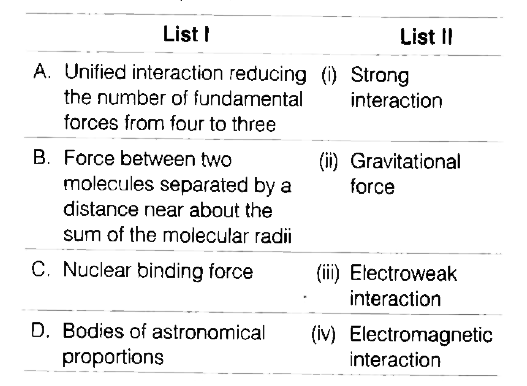The ratio of the De-Broglie wavelength for the electron and proton moving the same velocity is mp−Mass of proton,me− Mass of electron)Solution in Telugu
mp:me
m2p:m2e
me:mp
m2e:m2p
The correct Answer is:A
As, we know that de-Broglie wave lengths
λ=hmv⇒λ∝1m
Here, m=mass of charged particle and v=velocity of particle
⇒λeλp=mpme
Topper's Solved these Questions
Similar Questions
Match the entries in List I with those in List II.
 02:28View Solution
02:28View SolutionAlbert Einstein was confermed with the Nobel prize in physics for his work on
01:08View SolutionAn electron of mass m_e and a proton of mass m_p are accelerated through the same potential difference. The ratio of the de Broglie wavelength associated with an electron to that associated with proton is
03:59View SolutionIf a proton and electron have the same de Broglie wavelength, then
03:55View Solutionदी-ब्रोग्ली तरंगदैर्ध्य का व्यंजन लिखिए । समान चाल से गतिशील इलेक्ट्रॉन एवं प्रोटॉन से सम्बन्ध दी-ब्रोग्ली तरंगदैर्ध्य का अनुपात ज्ञात कीजिए । प्रोटॉन का द्रवमान इलेक्ट्रॉन के द्रवमान का 1840 गुना हैं ।
05:26View Solutionसमान चाल से चलते हुए एक इलेक्ट्रॉन तथा एक प्रोटॉन की दी-ब्राग्ली तरंगदैर्ध्य का अनुपात ज्ञात कीजिए ।
मान लीजिए की प्रोटॉन का द्रव्यमान, इलेक्ट्रॉन के द्रव्यमान का 2000 गुना हैं02:59View Solutionयदि प्रोटॉन का द्रव्यमान इलेक्ट्रॉन के द्रव्यमान का 1840 गुना है , तो समान विभवांतर पर त्वरित इलेक्ट्रॉन तथा प्रोटॉन से संबद्ध डी - ब्रॉग्ली तरंगदैर्घ्य की निष्पत्ति क्या होगी ?
02:51View SolutionDetermine the de Broglie wavelength of an electron moving with velocity 106m.s−1. What will be the de Broglie wavelength of a proton, moving with the same velocity? Given, Planck's constant =6.62×10−34J.s, mass of electron =9.1×10−31kg, mass of proton is 1840 times that of an electron.
01:44View Solutionde Broglie wavelength of the wave asociated with a moving electron and a proton are equal. Show the velocity of electron is greater than that of the proton.
04:01View SolutionThe ratio of the De-Broglie wavelength for the electron and proton moving the same velocity is mp−Mass of proton,me− Mass of electron)
01:05View SolutionElectron are accelerated through a potential difference V and protons are accelerated through a potential difference of 4 V. The de-Broglie wavelength are lamda_e and lamda_p for electrons and protons, respectively The ratio of lamda_e/lamda_p is given by ( given , m_e is mass of electron and m_p is mass of proton )
01:12View SolutionIf a proton and electron have the same de-Broglie wavelength, then
03:52View SolutionAn electron of mass me and a proton of mass mp are accelerated through the same potential. Then the ratio of their de Broglie wavelengths is
01:55View SolutionIf proton and electron have same de-Broglie wavelength then….
05:08View SolutionIf a proton and electron have the same de Broglie wavelength, then
02:05View SolutionAn electron of mass m_e and a proton of mass m_p are accelerated through the same potential difference. The ratio of the de Broglie wavelength associated with an electron to that associated with proton is
View Solution

